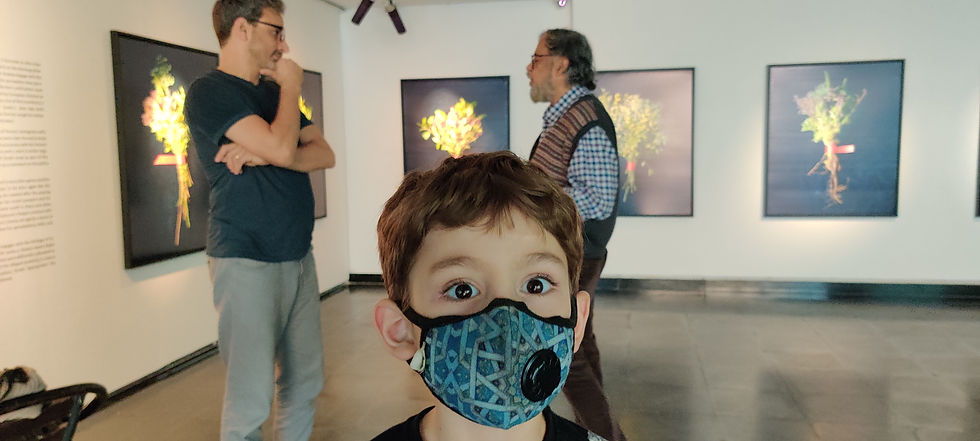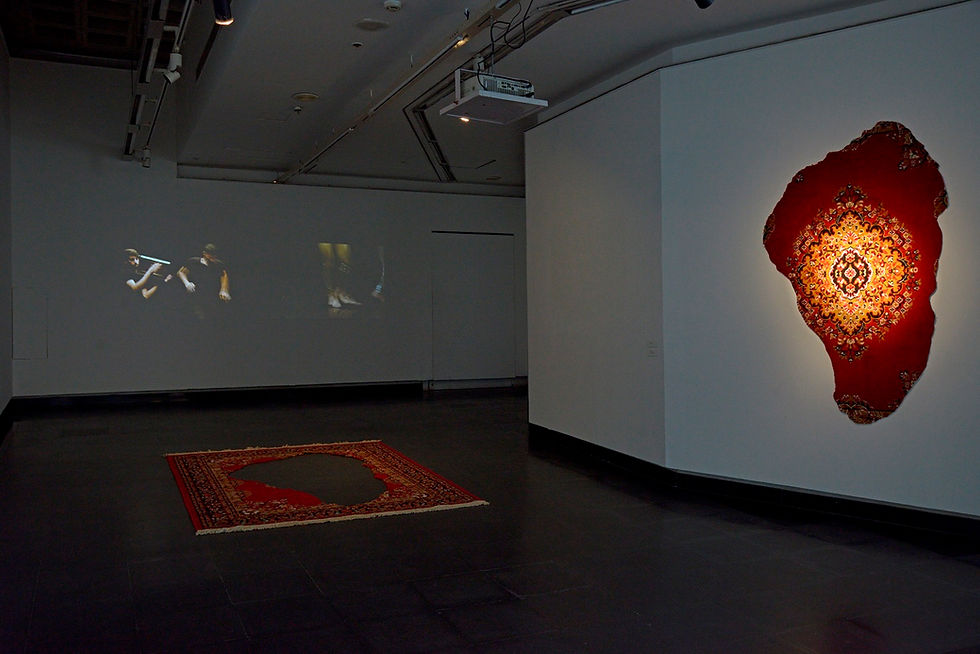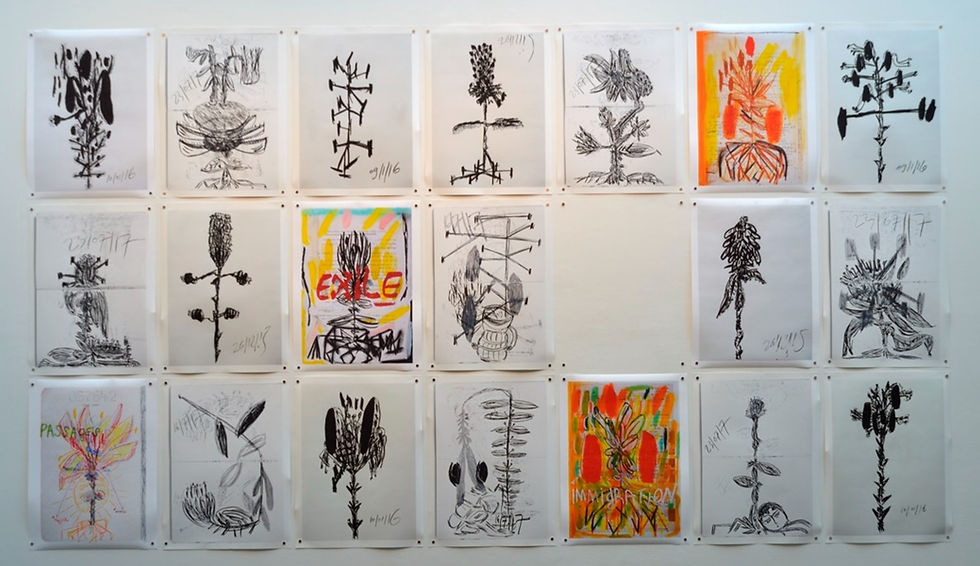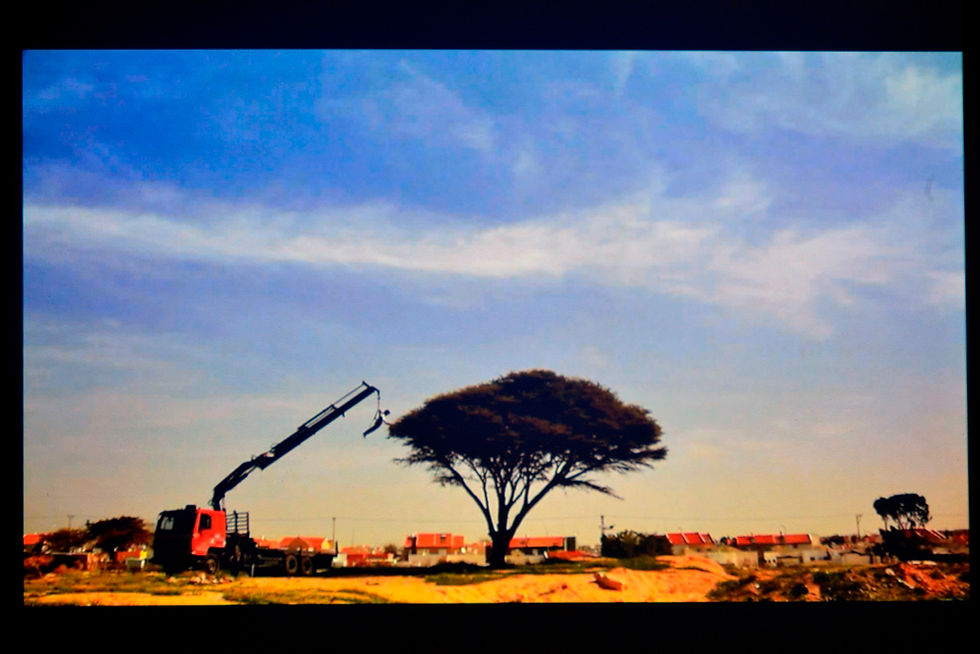In Another Green
- Ranjan Kaul

- Dec 16, 2021
- 7 min read
by Ranjan Kaul
Good contemporary conceptual art is always intriguing and exciting because it is nuanced, meaningful, open to interpretation, and there is always something new to learn. It is with this thought that I visited Galerie Romain Rolland at Alliance Francaise, New Delhi, along with Aakshat Sinha, where the works of two formidable conceptual Israeli artists, Leor Grady and Joseph Dadoune, are currently on display. Titled “In Another Green” and curated by Achia Anzi, the exhibition is presented under the aegis of the Embassy of Israel in collaboration with Alliance Francaise. The exhibition borrows its title from the poem, “Preliminary Background Remarks” by the Algerian-born Israeli poet, Erez Biton, which articulates the disintegration of Eastern Jewish traditions in Israel.
(Photos courtesy of Aakshat SInha)
Achia Anzi is waiting for us as we enter the gallery. He tells us that the poem is about the poet’s conflicting cultural position and heritage as an Eastern Jew. In the poem Biton remembers his mother from “the village of green bushes of another green” and the “cradle of nightingales”, and his father “whose knowledge of the synagogue’s customs was second to none” (free translations of the poem given within quote marks have been provided by Anzi). The poet (Biton) is the one who would recite Bach's Masses in the Moroccan Jewish dialect of Arabic. In this manner Biton creates a fusion between East and West (Western classical music recited in an Eastern dialect), but he also underlines a religious commonality between the Christian Masses of Bach and his own religious background.

Achia Anzi in conversation with Ranjan Kaul; Anzi's son is in the foreground
(Photo courtesy of Aakshat Sinha)
As Anzi, who himself is a half Yemeni Jew, explains in his curatorial note, the exhibition engages with communities whose traditions were marginalized in Israel. The selected artworks, although in rather differing ways, use “nature” as a visual metaphor. “Eastern Jews” (also referred to as Mizrahi Jews) refers to those who migrated to Israel from Arab countries and the Muslim world, from 1948 onward from countries such as Yemen, Algeria, Turkey, Libya, etc. and who currently constitute roughly fifty per cent of Israel’s population. As the curatorial note explains, “Western European Zionists regarded the Eastern Jews as ‘natural workers’; so, while celebrating their ‘primitiveness’ they also suspected their commitment to the ideals of Zionism and regarded them as culturally undeveloped.” When talking with Anzi, he underlined racism as the major cause for the prevailing tensions between the East and the West in Israel.
Anzi brings in notions of ‘coloniality’ and ‘decoloniality’ to analyse the works of both artists and approaches them through the prism of the “colonial matrix of power and with the perception that pre-modern societies are closer to nature.” While colonialism is a term familiar to us, seldom do we speak of ‘coloniality’ or ‘decoloniality’ in the same breath – the terms have entered the domain of academic discourse more recently with somewhat different connotations. Coloniality does not necessarily imply physical occupation and governance, but it does refer to the “political, economic, cultural and intellectual domination by the West over the past five centuries”, which emerged in the wake of colonialism and persists. Further, decolonial thinkers regard colonialism and modernity as not separate phenomena but closely interlinked – in fact, they maintain that coloniality is intrinsic to modernity – two sides of the same coin, albeit its darker side.
Leor Grady is an Israeli-born, second-generation immigrant from Yemen whose family settled in East Ramat Gan located east to the municipality of Tel Aviv. A conceptual artist, he explores themes of home and identity politics through various mediums. In the works on display, he goes back to the past and the heritage of his community to discover his own identity. In the “Bouquet” series of works, he uses traditional herbs that are cultivated by Yemeni Jews for daily use – in cooking as spices, medicine, religious rituals, and so on. Bunching and tying the herbs together, as one would flower bouquets, he photographs the “bouquets” against dark blue velvet cloth, giving them a regal look as one would see in a synagogue. The larger-than-life prints, accentuated by LED beams focussed on their centre, assume the appearance of giant bouquets. There is poetry, irony and symbolism in this deliberate reversing of the use of the herbs, shedding them of their daily-use mundanity and repositioning them as celebratory offerings imbued with reverence and adulation. Unlike flower bouquets whose individual stems are trimmed at the bottoms, the artist has chosen to retain the roots to symbolize the uprootedness that the artist feels about his situation; equally significant is the choice of the broad red ribbons to bunch them together, according them perhaps the feeling of togetherness and bonding experienced by the traditional Yemeni community. I wonder though the significance of red and why the artist chose only red ribbons and not any other colour.


In his Untitled (2019) work that uses a carpet, Grady harks back to the story of Yemeni immigrants who were invited to settle on the shores of the Sea of Galilee (Kinneret) in 1912 by the then Zionist leadership but were later put under such pressure that they had to leave. In the work, Grad appropriates the image of the Sea of Galilee that, as Anzi says, “in the Israeli consciousness resonates with Zionist pastoralism”, instilling it with an alternative connotation that speaks against Yemeni oppression. The cut out, symbolizing the void and erasure of their presence, is separately displayed on the wall to reclaim and assert, as it were, their rightful place and identity in Israeli historiography.

(Photos courtesy of Aakshat SInha)
Inspired by the poem, “Eye and the Heart”, which is a dialogue between the two, Grady’s video work bearing the same title presents two pairs of dancers juxtaposed side by side as shown in two videos running simultaneously on the projected screen. The video on the left of the screen shows two Yemeni youth in casual clothing who have imbibed the dance through tradition performing emotively (the ‘heart’), while the bare-chested pair of professionally trained dancers on the right have consciously learned the dance through observation (the ‘eye’). The difference in the two performances is noticeable: the former are natural and intuitive and dance with ease; the professional pair, though performing the dance gracefully do so unnaturally, with precision and synchronicity to a fault. Through the video art, Grady brings to the fore the significance of embodied knowledge as seen through the bodies of the Yemeni youth.
Born in Nice, Yoseph Joseph Yaakov Dadoune is a French-Israeli artist whose works also resonate with issues related to colonialism, identity and gender. His interests extend to the tensions between East and West and between centralized power and the periphery. His drawings of flowers, rendered with aggressively bold brush strokes, are at complete variance to Grady’s bouquets. But he too, like Grady, reverses their representation in his own way – while local flora in Zionist art signify rootedness and belonging, here Dadoune uses flowers as a visual metaphor for uprootedness, exile and migration. The expressive drawings (blown up for viewing) are evocative and disturbing at the same time, often sans the beauty and gentleness of the petals, and only showing the pistils and stamens. In a couple of drawings he created after his mother’s demise, he inscribes the words ‘immigration’, exile’, and ‘passages’ over the images of her Israel passport and immigration forms as seen in his two series, Orphan (2017) and Exile (2018). Curiously, in the collective display of his drawings in the exhibition, a rectangular space is left empty – representing as though a void or erasure; however, Curator Anzi says it was not really intentional but happened intuitively!


Guided by the pragmatism of the early Zionist leadership, Eastern immigrants were literally ‘dumped’ in the development towns in the wasteland of southern Israel to make ‘the desert bloom’. The video work that Dadoune created is a sharp comment on the way the immigrants were settled in the desert. In the video shot in desert sands, we see machines first digging deep holes in the desert ground and then thrusting brutally cypress and palm trees (both trees are meaningful symbols in Zionist art) in the created holes and burying them forever in the sand. In one image, as a palm tree is forced down, we see the last of the long leaves, flaying out in a last plaintive cry in the wilderness, as it were, before disappearing in the sand. Unlike Grady who wishes to resurrect and reawaken Yemeni tradition and spirit, Dadoune sees the burial as necessary for reconciliation and coming to terms with the present reality – an erasure of the past, to enable an inexorable rebirth.
(Video courtesy of Aakshat Sinha)
(Video courtesy of Aakshat Sinha)
In the next set of two videos titled, Phoenix I and Phoenix II, shot over the city of Ofakim in southern Israel, the video art speaks of the proverbial bird being reborn, where we see the artist himself being hauled up by a machine and literally hovering in the sky over the city, as if he were indeed the phoenix.


(Photo courtesy of Aakshat Sinha)
(Video courtesy of Aakshat SInha)
Interestingly, within the gallery, the manner in which the curator has assigned space to the works of Grady and Dadoune itself makes a statement – while Grady’s art that goes back to past traditions has been confined to the darker areas, Dadoune’s more reconciliatory works that look to the future are deliberately displayed in the brighter section below the skylight. However, the works of the two artists are not distinct, and need to be viewed together as the visual expression of voices that, as Anzi says, has been “subdued by the Israeli mainstream and also foreground the cultural and visual traditions that heretofore were not considered worthy of artistic attention”. While the works in the exhibition are limited to the socio-cultural dynamics playing out in Israel, we can view the show as a reflection of similar concerns that would resonate with other countries as well – issues of race, identity and cultural domination in the post-colonial world. Seen in this light, this applies to India as well, which has faced centuries of colonial domination and oppression. Even after over seventy years of Independence, the country continues to see persisting social divides and an increasingly polarizing polity in respect of caste, religion, race, customs, traditions and language. To that extent, the relevance and significance of holding an exhibition of the two Israeli artists located in the capital city of India cannot be lost.
The exhibition will remain open till 23 December 2021, daily from 11 am to 7 pm.
(The photographs and videos given above are courtesy of photographer Harry, unless otherwise stated.)

Ranjan Kaul is an artist, art writer, author and Founding Partner of artamour.
His art can be viewed on www.ranjankaul.com












Comments